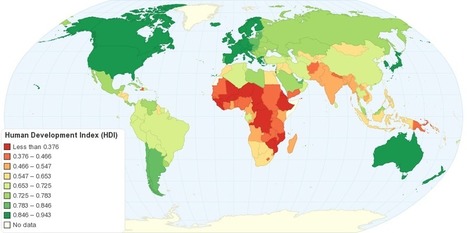 Your new post is loading...
 Your new post is loading...
Forget slogans and posters. Forget mission statements. Forget culture decks. A survey of over 400,000 people across the U.S. found that when employees believe promotions are managed effectively, they are more than two times as likely to give extra effort at work -- and to plan for having a long-term future with their company. But wait, there's more: When employees believe promotions are managed effectively, they are more than five times as likely to believe their leaders act with integrity. The result? At those companies, employee turnover rates are half that of other companies in the same industry. Productivity, innovation, and growth metrics outperform the competition. For public companies, stock returns are almost three times the market average.
Via The Learning Factor, Jim Lerman

|
Scooped by
Jim Lerman
|
What economists around the world get wrong about the future. The idea that economic growth can continue forever on a finite planet is the unifying faith of industrial civilization. That it is nonsensical in the extreme, a deluded fantasy, doesn't appear to bother us. We hear the holy truth in the decrees of elected officials, in the laments of economists about flagging GDP, in the authoritative pages of opinion, in the whirligig of advertising, at the World Bank and on Wall Street, in the prospectuses of globe-spanning corporations and in the halls of the smallest small-town chambers of commerce. Growth is sacrosanct. Growth will bring jobs and income, which allow us entry into the state of grace known as affluence, which permits us to consume more, providing more jobs for more people producing more goods and services so that the all-mighty economy can continue to grow. "Growth is our idol, our golden calf," Herman Daly, an economist known for his anti-growth heresies, told me recently. Tags: op-ed, economic, industry, sustainability, development, consumption, climate change, environment, resources.

|
Scooped by
Jim Lerman
|
"Women are the backbone of the development of rural and national economies. They comprise 43% of the world’s agricultural labor force, which rises to 70% in some countries. In Africa, 80% of the agricultural production comes from small farmers, who are mostly rural women. Women comprise the largest percentage of the workforce in the agricultural sector, but do not have access and control over all land and productive resources. Realizing the importance of rural women in agriculture is an important aspect of gender relations. In many countries, the role of women in agriculture is considered just to be a 'help' and not an important economic contribution to agricultural production. Giving support to rural women is a way of breaking the vicious cycle that leads to rural poverty and to the expansion of slums in the cities, where the poor get poorer. Development strategies should consider rural women as the epicenter, paying special attention to their social skills both within and without agriculture sector."

|
Scooped by
Jim Lerman
|
"This map shows Human Development Index (HDI) for 169 countries in the World. The HDI is a comparative measure of life expectancy, literacy, education, and standard of living for countries worldwide. The HDI sets a minimum and a maximum for each dimension, called goalposts, and then shows where each country stands in relation to these goalposts, expressed as a value between 0 and 1, where greater is better. The Human Development Index (HDI) measures the average achievements in a country in three basic dimensions of human development: health, knowledge and standard of living." Tags: development, statistics, worldwide.
|
We might spend days, months, or even years trying to figure someone out. Is he who he says he is? Should I trust her? The wheels in our head spin as we think of all the variables and how they'll play out. And still, we keep hearing that we should just listen to our instincts. Complicated questions, simple answer. What should we do, and where did this whole idea of the gut instinct come from, anyway? Intuition isn't some magical, mysterious quality that we carry with us. It actually comes from the knowledge and past experiences that we all carry. Even if we're unable to explain why we feel the way we do, there's a logical explanation behind our gut feelings. Whenever you encounter anything new, the unconscious side of your brain is constantly making assessments. It takes in certain cues, such as a smile or parts of a story, and then matches it with something similar in our database of memories to come up with a conclusion. Meanwhile, our conscious side remains unaware of this rapid process taking place.
Via The Learning Factor, Dennis Swender
New study provides one of the strongest cases yet that the planet has entered a new geological epoch Tags: Anthropocene, development, land use, environment, environment modify.
Via Verturner

|
Scooped by
Jim Lerman
|
Mexico’s cities are ballooning in population while rural and indigenous communities, where there are still over 60 indigenous languages other than Spanish spoken, are disappearing. For many indigenous families, illiteracy and the powerful forces of racism and discrimination can often offset the lures that brought them to migrate to urban centers.
The northern border with the United States is not the only destination for Mexican migrants. For millions, the bustling cities, which offer hopes of better jobs and education lure many from their traditional rural, and often indigenous communities. What they find in the cities is a mix of hope and hardship.
Tags: Mexico, indigenous, economic, development, migration.

|
Scooped by
Jim Lerman
|
by Clive Thompson
"Google Glass is the company’s attempt to mainstream what the tech industry calls wearable computing, to take the computer off your desk or out of your pocket and keep it in your field of view. In a world where we’re already peering at screens all day long, pecked at by alerts, the prospect of an eyeball computer can provoke a shudder. But over several weeks of using the device myself, I began to experience some of the intriguing — and occasionally delightful — aspects of this new machine. I got used to glancing up to start texting and e-mailing by addressing its surprisingly accurate voice-transcription capabilities. (I admit I once texted my wife while riding my bicycle.) I set up calendar reminders that dinged in my ear. I used an app that guided me back to my car in a parking lot. I sent pictures of magazine articles to Evernote, so I would have reminders of what I’d read. I had tweets from friends float across my gaze.
"Despite my quick adoption, however, only rarely did I accomplish something with Glass that I couldn’t already do with, say, my mobile phone. When I first heard about the device, I envisioned using it as a next-level brain supplement, accessing brilliant trivia during conversations, making myself seem omniscient (or insufferable, or both). This happened only occasionally: I startled a friend with information about the author of a rare sci-fi book, for example. But generally I found that Googling was pretty hard; you mostly control Glass with voice commands, and speaking queries aloud in front of others was awkward."
|



 Your new post is loading...
Your new post is loading...






















Great Study of 400k employees . So don't waste time on that culture deck ...Promote your best people... if teams matter promote the best team player... if productivity matters promote the best at that... the companies that do this have less turnover, more innovation and better engagement . Carrier Guidance big key. #ADPELEFY18 #offthebenchleadership #Workhappy #hellowork
Great insight "When employees believe promotions are managed effectively, they are more than five times as likely to believe their leaders act with integrity."